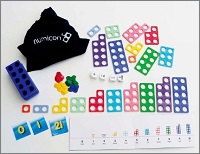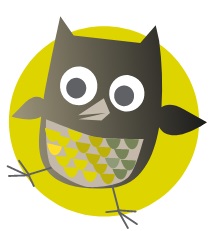As an Early Years teacher with twenty years of experience (and mum to two young girls), I am a huge fan of Numicon.
The multi-sensory shapes are my go-to for introducing maths to preschoolers. In this blog post, I talk about what Numicon is, how it works, and a couple of my favourite activities to get the most out of this versatile resource.
What is Numicon?
Numicon is a system of flat, plastic shapes with holes. Each shape represents a number from 1–10 and each number has its own colour. The pattern of holes is arranged in pairs, which makes it easier for children to make connections between numbers (for instance, seeing that each number is ‘one more’ than the last).
The aim of Numicon is to make numbers real for children. It is an effective, multi-sensory resource because it helps children to physically see and feel the value of numbers, and see the relationships between numbers.
You can find out more about Numicon on the Numicon guide for parents page.
Using Numicon at home
Everything you will need to get your child started with Numicon is included in the 1st Steps with Numicon at Home Kit, which provides a step-by-step guide to learning about numbers in a fun and interactive way.
The kit is geared towards pre-school children aged 3–5, and my three-year-old absolutely loves it. As well as Numicon shapes, pegs, and other equipment, the kit includes a booklet with a variety of clearly illustrated activities, and explanations of the maths concepts that your child is exploring through their play. For each activity, you are provided with a list of the mathematical language that you can use around your child.
If you don’t have the kit at home, don’t worry – you can download free cut-out Numicon shapes to follow along with your own version of these activities.
1. Visualising numbers
Try using a ‘feely bag’ to help your child build up a mental image of the numbers one to ten. For example:
- Have your child close their eyes.
- Put one Numicon shape in an opaque bag.
- See if your child can tell your what number it is just by feeling it.
When your child has to ‘feel’ for a number, they have to visualise the Numicon patterns, which helps them to develop their own mental image of numbers.
This proved challenging for my little girl when we initially used the bag. She insisted on emptying the Numicon tiles over the table so she could see all the pieces! We spent a lot of time talking about the colours, shapes, and sizes of the different tiles, comparing them to each other. I modelled the appropriate language (such as find, match, feel, the same as, and the names of the colours) so that she had the mental tools to think about and describe what she was feeling.
She is now a pro at identifying pieces in the feely bag and enjoys using it. She can tell me if a piece is big or small, has a chimney or not (odd/even numbers), and also puts her fingers in the holes to count before pulling the pieces out of the bag. Using the feely bag has helped her to develop a mental picture of the Numicon shapes, which is an important step in developing mental imagery of numbers.
2. Making patterns
This activity makes use of the 52 pegs in the At Home kit. They can be used for a variety of pattern-making activities. For instance, the 10×10 baseboard is designed to hold both Numicon shapes and pegs. It can therefore be used with the picture overlays to make matching puzzles.
My little girl loves to use the pegs on the baseboard. Initially, I let her explore and play with the pegs freely and she filled the baseboard with pegs in random order. However, she was keen to copy me when I began modelling how to make a pattern. I only used two colours to keep it simple and she very quickly wanted to make her own patterns (‘I do it myself Mummy!’). She loved making necklaces with her pegs. To begin with, it is a good idea to limit the choices of colour and then build up more when your child becomes more confident.
The coloured pegs fit into the Numicon pieces, so there are lots of opportunities for learning using these resources together. For example, you could try:
- Matching peg patterns to Numicon shapes.
- Making number towers.
- Copying patterns.
- Using the feely bag to make Numicon shapes with pegs from memory.
In my next post, I will be sharing how Numicon can help you explore sequencing, ordering, number names, and counting with your child.
Numicon kits for parents
1st Steps with Numicon at Home Kit
Designed specifically to help parents support their children’s maths progression in Foundation Stage and Key Stage 1.
The kit includes a 100-square baseboard, 52 coloured pegs, 32 shapes, 10 numeral cards, three threading laces, picture overlays, a feely bag, an inspiring activity book, and more.
Homework Activities Intervention Resource kit
Especially created for use at home, Homework Activities Intervention Resource kit supports children’s mathematical development and learning outside of school.
The kit includes dice, 60 coloured counters, 21 numeral cards, 30 shapes, a large table-top number line, and more.
Bag of Numicon shapes 1–10
A set of 10 Numicon shapes to practise maths at home.
The tactile, multi-sensory approach helps your child build their mathematical fluency, reasoning, and problem-solving.


